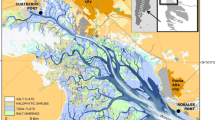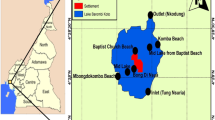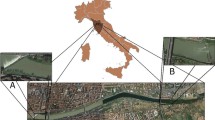Summary
Concentrations of Cd, Cr, Cu, Fe, Mg, Mn, Pb, Zn, Ca and K were examined in tissues of the troglobitic (obligatory cave-dwelling) crayfish Orconectes australis australis and troglophilic (facultative cave-dwelling) species Cambarus tenebrosus. These two species cohabit a stream in Merrybranch Cave, located in rural White Co., Tennessee. Tissue concentrations of essential metals did not exhibit any trends between species. In contrast, Cd and Pb concentrations were found to be significantly greater in O. a. australis for almost all of the tissues analyzed. The higher Cd and Pb concentrations in O. a. australis are thought to be due to the increased longevity of this troglobitic species. Because of the toxicity of Cd and Pb, chronic exposure to relatively low concentrations of these metals could cause changes in mortality, fecundity or behavior in aquatic organisms possessing long life spans. The bioaccumulation of metals from low level, non-point sources is discussed in relation to life history strategies.
Similar content being viewed by others
References
Anderson, R.V., Brower, J.E.: Patterns of trace metal accumulation in crayfish populations. Bull. Environ. Contam. Toxicol. 20, 120–127 (1978)
Anon.: Cadmium in the environment: toxicity, economy, control. Environmental Directorate, Organization for Economic Co-operation and Development, 88 p. Paris 1975
Atchison, G.J., Murphy, B.R., Bishop, W.E., McIntosh, A.W., Mayes, R.A.: Trace metal contamination of bluegill (Lepomis macrochirus) from two Indiana lakes. Trans. Am. Fish. Soc. 106, 637–640 (1977)
Barr, A.J., Goodnight, J.H., Sall, J.P., Helwig, J.T.: A Users Guide to SAS 76. Raleigh, N.C. SAS Institute, Inc. (1976)
Brown, B.E.: Uptake of copper and lead by a metal tolerant isopod Asellus meridianus Rac. Freshwater Biology 7, 235–244 (1977)
Bryan, G.W.: Some aspects of heavy-metal tolerance in aquatic organisms. Soc. Expt. Biol. Seminar Series 2, 7–34 (1976)
Burbanck, W.D., Edwards, J.P., Burbanck, M.P.: Toleration of lowered oxygen tension by cave and stream crayfish. Ecology 29, 360–367 (1948)
Caine, E.A.: Comparative ecology of epigean and hypogean crayfish (Crustacea: Cambaridae) from northwestern Florida. Amer. Midl. Nat. 99, 315–329 (1978)
Cooper, M.R.: Sensory specialization and allometric growth in cavernicolous crayfishes. Proc. 4th Internat. Congress Speleol, Yugoslavia (1965), 203–208 (1969)
Cooper, J.E.: Ecological and behavioral studies in Shelta Cave, Alabama, with emphasis on decapod crustaceans. Ph. D. thesis, University of Kentucky (1975)
Dickson, G.W., Franz, R.: Respiration rates, ATP turnover and adenylate energy charge in excised gills of surface and cave crayfish. Comp. Biochem. Physiol. A. (In press, 1979)
Eberly, W.R.: Competition and evolution in cave crayfishes of southern Indiana. Syst. Zool. 9, 29–32 (1960)
Engemann, J.G.: Indirect evidence shows deep-sea benthos may reach extreme ages as individuals. Amer. Zool. 18, 666 (1978)
Enk, M.D., Mathis, B.J.: Distribution of cadmium and lead in a stream ecosystem. Hydrobiologia 52, 153–158 (1977)
Fassett, D.W.: Cadmium. In: Metallic Contaminants and Human Health. (D.H.K. Lee ed.), New York: Academic Press 1974
Franz, R.: Ecological strategies of closely-related surface and troglobitic Florida crayfishes. Bull. Ecol. Soc. Amer. 59, 70 (1978)
Giesy, J.P., Jr., Wiener, J.C.: Frequency distributions of trace metal concentrations in five freshwater fishes. Trans. Am. Fish. Soc. 103, 729–735 (1977)
Giesy, J.P., Bowling, J.W., Kania, H.J.: Cadmium and zinc accumulation and elimination by freshwater crayfish. Arch. Environ. Contam. Toxicol. (1979) (submitted)
Hobbs, H.H., III.: The population dynamics of cave crayfishes and their commensal ostracods from southern Indiana. Ph. D. thesis. Indiana Univ. (1973)
Jegla, T.C.: Studies of the eyestalk, metabolism, and molting and reproductive cycles in cave crayfish. Ph. D. thesis. Univ. of Illinois (1964)
Kubota, J., Mills, E.L., Oglesby, R.T.: Lead, Cd, Zn, Cu and Co in streams and lake waters of Cayuga Lake basin, New York. Environ. Sci. Technol. 8, 243–248 (1974)
Liebscher, K., Smith, H.: Essential and non-essential trace elements. Arch. Environ. Health 17, 881–890 (1968)
Mathews, R.C., Jr., Bosnak, A.D., Tennant, D.S., Morgan, E.L.: Mortality curves of blind cave crayfish (Orconectes australis australis) exposed to chlorinated stream water. Hydrobiologia 53, 107–111 (1977)
Mellon, De F., Jr.: Retention of oculomotor reflexes in blind cave-dwelling crayfish. Brain Res. 134, 191–196 (1977)
McIntosh, A., Bishop, W.: Distribution and effects of heavy metals in a contaminated lake. Purdue Univ. Water Resources Research Center, Technical Report No. 85 (1976)
Morrison, D.F.: Multivariate Statistics Methods. New York: McGraw-Hill Book Co. 1967
Patterson, C.C.: Contaminated and natural lead environments of man. Arch. Environ. Health 11, 344–360 (1965)
Stenner, R.D.: The concentration of cadmium, copper, lead and zinc in sediments from some caves and associated surface streams on Mendip, Somerset. British Cave Res. Assoc. 5, 113–120 (1978)
Thorp, J.H., Giesy, J.P., Wineriter, S.A.: Effects of chronic cadmium exposure on crayfish survival, growth, and tolerance to elevated temperatures. Arch. Environ. Contam. Toxicol. 8, 449–456 (1979)
Turekian, K.K., Cochran, J.K., Kharkar, D.P., Cerrato, R.M., Vaisnys, J.R., Sanders, H.L., Grassle, J.F., Allen, J.A.: Slow growth rate of a deep-sea clam determined by 288RA chronology. Proc. Nat. Acad. Sci. 72, 2829–2832 (1975)
Weingartner, D.L.: Production and trophic ecology of two crayfish species cohabiting an Indiana cave. Ph. D. thesis. Michigan State Univ. (1977)
Wolfe, D.A., Cornwell, D.G.: Carotenoids of cavernicolous crayfish. Science 144, 1467–1469 (1964)
Author information
Authors and Affiliations
Rights and permissions
About this article
Cite this article
Dickson, G.W., Briese, L.A. & Giesy, J.P. Tissue metal concentrations in two crayfish species cohabiting a tennessee cave stream. Oecologia 44, 8–12 (1979). https://doi.org/10.1007/BF00346389
Received:
Issue Date:
DOI: https://doi.org/10.1007/BF00346389




